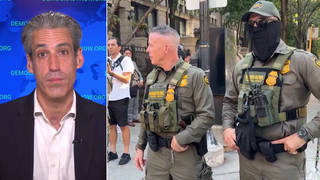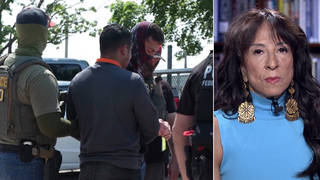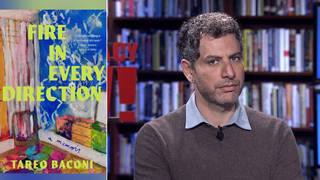
Guests
- Dang Hong Nhut71-year-old victim of Agent Orange. She was a part of the Vietnamese resistance for five years between 1961 and 1966 and was heavily sprayed with Agent Orange during that time. Since then, she has had several miscarriages and now has cancer. Her husband, who was also sprayed with Agent Orange, died of cancer in 1999.
- Tran Thi Hoana 21-year-old university student from Vietnam and a second-generation victim of Agent Orange. Her mother was sprayed during the war.
The Second National Congress of the Vietnam Association for Victims of Agent Orange just concluded in Hanoi Wednesday. Vietnamese victims continue to demand accountability and compensation from the US government as well as the largest makers of Agent Orange, Dow Chemical and Monsanto. Earlier this year, a delegation of women victims of Agent Orange toured the United States. We speak with two of them: 71-year old Dang Hong Nhut, who has had several miscarriages and now has cancer, and 21-year-old Tran Thi Hoan, a second-generation victim of Agent Orange who was born without two legs and with one hand seriously atrophied. [includes rush transcript]
Transcript
AMY GOODMAN: We continue on this lawsuit that has just been filed against the former Halliburton subsidiary, now its own company, KBR. It’s based in Houston. Michael Doyle joins us from Houston, lead counsel for the Indiana Guardsmen who have filed the lawsuit. Jody Aistrop is one of those Indiana National Guard who are suing KBR.
The lawsuit, Michael Doyle, talks about KBR seeking to conceal the contamination and, once discovered, limiting exposed individuals’ knowledge about the level of poisoning they suffered. First of all, how did the chemical get there? And how do you know all of this?
MICHAEL DOYLE: Well, we know the chemical was there, because the Iraqis apparently were using it. It was being used as an anti-corrosive. This is a huge water plant that’s used to pump water down into oil wells so the oil keeps coming up. And this is basically — was used. It had been banned pretty much everywhere in the world for a number of years, but they were using it to keep the pipes clean. And it contained an extremely high amount, almost pure hexavalent chromium.
There are some indications, and it’s really just speculation, but there are some indications from the Iraqis that they gave to some of the civilian workers on site, that as part of the sabotage by the Baathist Party, Saddam Hussein’s folks, before the Americans got there, they had spread it around even more than it had been before. And that’s why, as a result, it was all over the place, not just in one limited area in this very large industrial site where these people were doing all this work and the Guardsmen were providing security on a daily basis.
The reason why we know a lot of this stuff is, a number — ten of the American civilian workers out there filed an arbitration claim, which is one of the things that Halliburton required all their employees, including of these Cayman Island subsidiaries of KBR, to sign an arbitration agreement to go work over there. Ten of these folks, including the medic on site, who is a fellow named Ed Black, who I think you could call him almost a whistleblower here, filed a claim. It’s pending in arbitration, and there has been testimony taken and documents produced in that arbitration that have kind of shed a lot of light about what the managers at the KBR level and the safety folks and the other managers involved knew about it.
And one of the important issues that came out in that was that as it became more and more clear — in other words, they kept getting reports of sodium dichromate out there, deadly carcinogen — their plant workers were getting sick, those people out there. The Cayman Island subsidiary folks were actually experiencing these blood clots, which unfortunately is the most acute sign of poisoning from hexavalent chromium. And that’s kind of the characteristic. They actually call it “chrome nose.” Even as they’re getting these reports, they put off doing any testing until after the windy season had ended. The very first — at least what they’ve owned up to — testing was done not when they were hired to do it, when they were supposed to do it back in April and May, but not until August, after these folks had been out there for three to four months.
And not only was the testing inadequate, they basically were very selective about how they did it, and it didn’t line up — the air testing didn’t line up with the soil testing. But when they actually did some blood testing on the civilian workers there, and almost all of them had elevated chromium, which just basically measures all the chromium in your blood, but when you’ve got these guys exposed, that’s a big red flag. There was actually a meeting here with the medical director of Halliburton/KBR and a number of the managers, where they discussed the need — or if you’re really going to test and see whether or not hexavalent chromium is in these guys, the incredibly dangerous substance, there’s a test you’re supposed to do, and they decided not to do that test. And unfortunately, not just for the civilians but also for the National Guardsmen, if that test isn’t done fairly shortly after the exposure — and they knew that — there’s no real way to document the level of exposure, so tracking these guys health-wise forward is going to be that much more difficult.
JUAN GONZALEZ: Well, Michael Doyle, we asked KBR to join us today, but they declined our request. And we did receive a statement from their director of corporate communications, Heather Browne. She said the company intends to vigorously defend — and I want — defend against the suit, and I want to read to you part of the statement. It says, quote, “We deny the assertion that KBR harmed troops and was responsible for an unsafe condition. KBR appropriately notified the Army Corps of Engineers upon discovery of the existence of the substance on the site and the Corps of Engineers concluded that KBR’s efforts to remediate the situation were effective. Further the company in no way condones any action that would compromise the safety of those we serve or employ.” I’d like to ask you to respond to that and also to what the military did, if they were informed by KBR, of the existence of this problem.
MICHAEL DOYLE: Well, thanks, Juan. I think that there’s really two things in there. One of them is that their indication that they informed the military in a timely manner — one of the things that has been provided to these soldiers by the National Guard was a timeline that was actually — we were able to attach to the complaint — that was apparently provided based on information the Army got from KBR. And one of the most glaring kind of issues in there is that when you look at it, it claims KBR didn’t know about this sodium dichromate on site until almost the end of July and then immediately notified the military. We know that’s not true.
Likewise, the issue about their remediation, they finally admitted that this was a problem. The actual top manager of KBR in Iraq did a site inspection in the middle of August in full protective gear. It still took him about three weeks before they finally said, “OK, we’ve got these blood tests now. Let’s go ahead and shut down the plant.” And they did eventually seal off the entire plant, seal off the sodium dichromate, more or less encase it all, and ensure that folks finally were given protective equipment that they should have had three months earlier and told about what was out there. But that’s a little bit late for the folks that had been working there for three to four months.
AMY GOODMAN: Jody Aistrop, what about the KBR workers inside? You were guarding outside, and you got sick. What happened to them?
JODY AISTROP: From the beginning, we were guarding inside. We didn’t actually pull outside until they deemed the site unsafe. So from the beginning of going into the plant for KBR to work on it, we were inside right with them. We would follow them around like we were attached to them.
AMY GOODMAN: And do you know what happened to any of them? Any of them suffering like you did the nose bleed, for example?
JODY AISTROP: The only thing that I know is I did some research on the net, and that’s where I found out about the lawsuit from Mr. Ed Black. I actually know Mr. Black. I protected him over there.
AMY GOODMAN: The medic?
JODY AISTROP: Yes, yes. And that’s how I know KBR, they were suffering the same symptoms that we were. And then, you know, I received a letter about the town hall meeting, and then the Guard informed us what was going on.
AMY GOODMAN: And when you all got these nosebleeds, again, what KBR told you, how they explained those nosebleeds away?
JODY AISTROP: We were basically told that it was due to dry air, the sand blowing, you know, it’s not that big a deal.
JUAN GONZALEZ: Michael Doyle, you filed the lawsuit now. In what court will it be heard? And when do you expect to begin taking — having discovery or depositions?
MICHAEL DOYLE: Well, it’s filed in federal court in Evansville, Indiana in the southern division — or Southern District of Indiana. The hope is, as soon as possible. We’ve been told by the folks we’re working with in Indiana that normal timetable is a year, year and a half for trial. We obviously intend to try and get to the bottom of it as soon as we can, as soon as the court will let us.
AMY GOODMAN: And the secret KBR memos that you got a hold of, can you talk about them?
MICHAEL DOYLE: No. I mean, there is some documents. Ed Black was actually able to obtain when he was there in Iraq, in Kuwait, some documents that, when he saw these, that made it real clear who knew and how long they knew it. Those documents aren’t protected. But as part of this arbitration deal, at least at this point, KBR has taken the position that every single document related to this is secret and can’t be released. So I really can’t talk about the documents. I can talk about the testimony, but the documents at this point are subject to a protective order.
AMY GOODMAN: The KBR memo from 2003 that shows the KBR managers talking about, acknowledging the presence of sodium dichromate?
MICHAEL DOYLE: Well, there is one that Ed Black actually obtained back in 2003 that we were able to file with the papers of the Guardsmen suit. But the great mass of documents, the really documentation of the timeline and all that stuff, I really am not at liberty to talk about, at least at this point.
AMY GOODMAN: Well, I want to thank you both very much for being with us, Jody Aistrop, former member of the Indiana National Guard — they were based in Tell City — one of sixteen soldiers who are suing KBR, which was owned by Halliburton, which was headed by Dick Cheney before he was Vice President; and Michael Doyle, lead counsel for the National Guardsmen. He is based in Houston, where KBR is based.
AMY GOODMAN: In our last segment, we’re going to go back to the Persian Gulf War, as we continue this special on poisons of war. But now we’ll go back even further. Juan?
JUAN GONZALEZ: Yes, to another US war, the Vietnam War. And we hear from the victims of the chemical poisoning caused by the deadly dioxin known as Agent Orange.
Between 1962 and 1971, US warplanes dumped about 18 million gallons of the poisonous dioxin over Vietnam. The Vietnamese government says this has left more than three million people disabled. Today, more than three decades after the end of the war, the effects of Agent Orange remain.
The Second National Congress of the Vietnam Association for Victims of Agent Orange just concluded in Hanoi Wednesday. Vietnamese victims continue to demand accountability and compensation from the US government as well as the largest makers of Agent Orange, Dow Chemical and Monsanto.
AMY GOODMAN: Earlier this year, a delegation of women victims of Agent Orange toured the United States. Dang Hong Nhut is seventy-one years old, a victim of Agent Orange, part of the Vietnamese resistance for five years between ’61 and 1966. She was heavily sprayed with Agent Orange during that time. Since then, she has had several miscarriages, now has cancer. Her husband, who was also sprayed with Agent Orange, died of cancer in 1999.
DANG HONG NHUT: [translated] In 1965, I visited my husband in Tay Ninh, Cu Chi. And when I was there, one day I heard the airplanes flying over there, and I hid in an underground shelter. And after the airplane flew away, I went out of the shelter, and I saw that the sky looked like very foggy, and I could see the white dust on the leaves of the trees over there. And I smelled something very irritating, and I felt very sick after that. I lived there for more than one month.
After that, I suffer from skin problems and diarrhea. And then, after that, each time I was pregnant, I had a miscarriage. So, continuously, I had five pregnancies and five miscarriages. And at one time, I was pregnant, and it was found out that it was a deformed fetus. In 2002, that was thirty-seven years after that, I had a tumor in my intestine, and I had to have an operation to have it taken out. And in 2003, I had another problem in my thyroid, and I had an operation in my thyroid.
I could not imagine how serious, how harmful and how poisonous this Agent Orange was. It is going with all my life. And that is why I am together with other Vietnamese plaintiffs. We filed our lawsuit in the US courts, and we would like to ask the US government as well as the US chemical companies to do something for us. Even though our lawsuit was turned down, was dismissed twice by the US courts, we continued to present our petition. We want to ask for justice for us. We want to ask for compensation for us, all the victims of Agent Orange. Agent Orange does not avoid anyone. We Vietnamese are victims. And also, there are victims from the US allied countries. And we all are victims, so we want to ask for justice, for compensation for us all, the victims.
AMY GOODMAN: Mrs. Dang Hong Nhut, do you know that one of our presidential candidates, John McCain, was a Vietnam vet? Do you have anything you would like to say to him?
DANG HONG NHUT: [translated] Who ever would be the president of the United States would have to pay attention to solve the consequences left behind by the war. Also, he should do something to help the victims, and he should be responsible and accountable for what the American troops caused in Vietnam. And he must have moral and legal responsibility to make compensations for the victims.
AMY GOODMAN: What message do you have for Monsanto, Dow, the other chemical companies who produced Agent Orange?
DANG HONG NHUT: [translated] Dow and Monsanto chemical companies, they are the ones that manufactured the Agent Orange that caused sufferings to the human beings and environment in Vietnam. They must be held accountable for what they did, and they must be accountable to make compensation for the victims and to clean up all the environment in Vietnam.
AMY GOODMAN: And what would you say to those who would say you were fighting a war with the United States, this is the cost of war?
DANG HONG NHUT: [translated] The war ends long time ago. However, still the Vietnamese victims, they are still suffering. This is something unacceptable, because during the war, someone might get killed. That’s understandable. When the war is over for a long time, but the Vietnamese victims, they are suffering, and nobody here makes any — has any responsibility towards them.
AMY GOODMAN: Dang Hong Nhut, a victim of Agent Orange poisoning. I also spoke to Tran Thi Hoan, a twenty-one-year-old university student from Vietnam. She had just come to the United States as part of this tour. She’s a second-generation victim of Agent Orange. Her mother was sprayed during the Vietnam War.
TRAN THI HOAN: I was born without two legs and one hand. Now I live in Peace Village in Tu Du Hospital, Ho Chi Minh City. Peace Village is the place to take care of the victim of Agent Orange very well. And now my Peace Village have sixty children. All of them are victims of Agent Orange.
AMY GOODMAN: Peace Village has sixty children?
TRAN THI HOAN: Yes.
AMY GOODMAN: What has it meant to you, Tran Thi Hoan, to be with other victims of Agent Orange?
TRAN THI HOAN: First time, I was scared, because I saw many defects. For example, they have a big head, and they cannot walk, they cannot see, and they only lie in the bed. Some of them can walk and can do something. You know, before when I come to Tu Du Hospital, I couldn’t go to school, because everybody thinks I will make their children will be sick and children scare me. So when I come to Peace Village, I can go to school, and I can do something, and I feel I am lucky.
AMY GOODMAN: You’re now a college student studying computers?
TRAN THI HOAN: Yes.
AMY GOODMAN: Why have you come to America, to the United States?
TRAN THI HOAN: I come here. I want to tell everybody about my story and the suffering of victims of Agent Orange in Vietnam. And I hope the US government will not make the war in other countries, because if they make the war, maybe have many, many children and many, many people will be look like me. And I hope when everybody can understand the suffering of victims of Agent Orange. And after that, many people, all people, will come with us to ask the US government and the chemical companies, will we have justice for us?
AMY GOODMAN: Tran Thi Hoan, twenty-one years old, university student from Vietnam, a second-generation victim of Agent Orange. I spoke to her several months ago, when she was here in the United States as part of this tour.
Last year, we also spoke to those who came to this country as part of the tour to let people know about the lawsuit against over three dozen chemical companies that manufactured the toxin, Nguyen Van Quy and Nguyen Thi Hong. Unfortunately, one of them has died since that time.
This is Democracy Now!
, democracynow.org, the War and Peace Report. Before we go to break, Juan, you’ve been looking at Agent Orange. We haven’t even talked about the tens of thousands of US soldiers who were affected, not to mention the millions of Vietnamese, effects of Agent Orange. You were looking at this decades ago.
JUAN GONZALEZ: Yeah. Well, you know, this is one of the great war crimes in American history that the media in this country, unfortunately, and our government continue to ignore. I remember almost thirty years ago, as a young reporter in Philadelphia, in about 1979, 1980, just after the war, I was covering the returning veterans from that war who were complaining about their exposures and their illnesses, and they thought it was related to Agent Orange. At the time, the government was denying it. Now the government gives compensation to some American soldiers for rashes or chloracne related to Agent Orange exposure.
But at the time, I noticed that there had been — there was a report — I think it was in Time magazine — that the Minister of Health of North Vietnam was conducting their own study of the effects of Agent Orange on these soldiers who had fought, the Vietnamese soldiers who had fought, and their families. So, by chance, I wrote a letter to the minister of North Vietnam and asked him, “When you finish your study, could you send me a copy?” I never expected to get an answer.
About four or five months later, I get a letter at the Philadelphia Daily News from the Minister of Health of North Vietnam, and it is in French, a typewritten — there were typewriters still in those days — a typewritten report, where the government had compared North Vietnamese soldiers who had gone into the south to fight and who had been exposed to Agent Orange and North Vietnamese soldiers who had stayed in the north and had never been exposed to Agent Orange. And they traced what was happening to their families. And they found enormous — much higher degrees of birth defects, miscarriages and sterility problems with the wives and also in the children, the birth defects in the children, of those who had gone south.
So, I go to my editor at the time at the paper, and I say, “Look, this study just came out, and nobody knows about it. And it’s clear proof that Agent Orange is causing major, major problems in the Vietnamese population.” My editor looked at it and said, “This is communist propaganda. It’s coming from an enemy of the United States. We’re not going to run it.” And they never published the article that I started to write on it. And here we are, thirty years later now, when you see these horrific pictures of what the impact has been on the Vietnamese population, and it’s amazing that the media in this country is still not providing sufficient coverage to the issue.
AMY GOODMAN: And just to clarify, this delegation that has come to the United States, well, this year and last year, last year two members of the delegation, this in 2007, Nguyen Van Quy and Nguyen Thi Hong, weeks after they left the United States after visiting, they died. We had interviewed Nguyen Thi Hong. And you can go to our website, democracynow.org, to see and watch and read that interview.
This is Democracy Now!, democracynow.org, the War and Peace Report. When we come back, we will look at the Persian Gulf War and US soldiers who got sick there, as we continue our special, “Poisons of War.” Stay with us.











Media Options